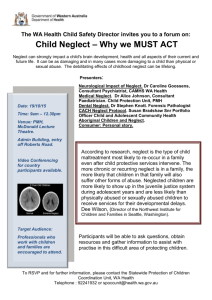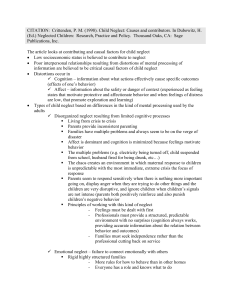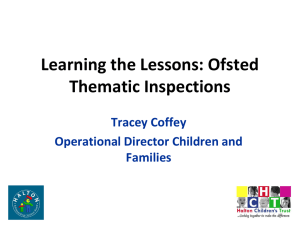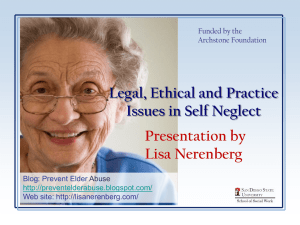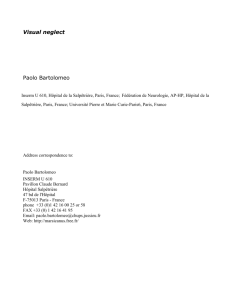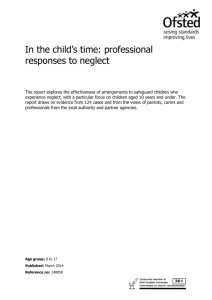Helen Richardson Foster
advertisement
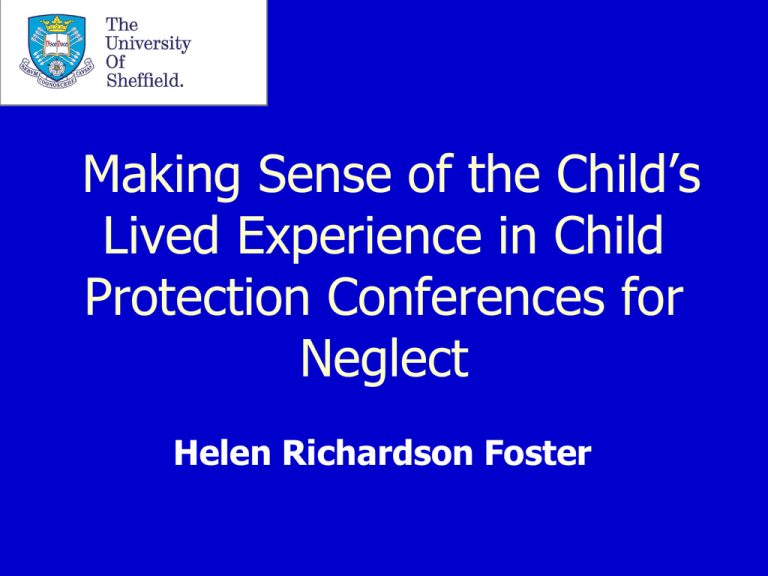
Making Sense of the Child’s
Lived Experience in Child
Protection Conferences for
Neglect
Helen Richardson Foster
Today I will talk about:
Background to the research
Research questions & methodology
Sample characteristics
The type of data presented in
conference
How does data presented relate to the
child’s daily lived experience?
The Rationale for the Research:
ESRC Case Studentship
“…failure to see through the eyes of the
child” (Lord Laming, 2009)
Why neglect?
Why child protection conferences?
The Working Together Definition of
Neglect
“…the persistent failure to meet a child’s basic physical and/or
psychological needs, likely to result in the serious impairment of the
child’s health or development. Neglect may occur during pregnancy as
a result of maternal substance abuse. Once a child is born, neglect
may involve a parent or carer failing to:
provide adequate food, clothing and shelter (including exclusion
from home or abandonment);
protect a child from physical and emotional harm or danger;
ensure adequate supervision (including the use of inadequate caregivers); or
ensure access to appropriate medical care or treatment.
It may also include neglect of, or unresponsiveness to, a child’s basic
emotional needs.”
(HM Government, 2013 p86)
Research Questions
1)
2)
3)
5)
6)
7)
8)
Who shares what information about a child and their family at a child
protection conference?
To what extent is information about parenting capacity, context and
issues explored in relation to the impact on the developmental
needs of the child?
How has information been obtained and presented about the child’s
experiences, wishes and feelings?
To what extent do conference members provide information about a
day in the life of the child?
What difference is there to the quality of information about individual
children and their lived experience if more than one child in the
family is discussed at the conference?
What information is used to inform the content of the child protection
plan?
What promoters and inhibitors do the workforce identify in relation to
maintaining a child focus?
Methodology and Sample
Stage 1:
Conference
Data
Audio recording and
documentary analysis.
Where neglect main
presenting concern or
category of harm.
14: 3 ICPCS, 11
reviews
In 1 LA / LSCB
Stage 2:
Interviews with
Conference Staff
Stage 3:
Focus Groups
Face to face with
conference chairs &
their managers; and
minute takers & their
managers.
Exploration of
Stage 1 findings
with staff from all
agencies who
attend conferences
26: 9 chairs,
13 minute takers,
2 managers &
2 supervisors
In 2 LA /LSCBs
6: 3 in each area
In 2 LAs/ LSCBs
The Conference Data – Characteristics 1
11 reviews, 3 initial conferences
Reviews: 3- 24 months, average of 9.5 months
6 ‘baby only’ conferences
5 large families of 4+ children
Family attendance: 12 mothers, 5 fathers, 3 teenage
children
Practitioners 2 to 13, 10 average
35 mins to 2 hours 8 mins, average 1hr17 mins
The Conference Data – Characteristics 2
All previously known to Children’s Social Care
Predominantly white British
Domestic violence
Alcohol and drug use
Parents: learning difficulties; mental health; physical
health
Children: Autistism; offending
What information is shared in
conferences?
Analysis methods
Purpose and structure of conference
Time spent on agenda items
Developmental
needs
40 - 60% (1hr of long meetings)
Parenting
7 - 38%
27% average for 1 child meetings
12% multiple child meetings
Planning
9 of 14 meetings <12% of meeting time
discussing threshold / planning
Least discussion of the Child’s Daily
Lived Experience
Baby only conferences
Historical concerns
I’ve got no concerns over the care that’s being provided to {Child
1} at the moment. Routines are all in place he’s feeding well.
(Social Worker, Conference Two)
Resistant parents
…when I’ve visited her I’ve not picked up that there’s been any
smell of alcohol or she’s not appeared intoxicated or anything
but I’m only seeing her for a fraction of the time and what she’s
doing outside of that time is quite difficult to really get a true
picture (Social Worker, Conference Three)
Most discussion of the Child’s Daily
Lived Experience
Older children
Education workers (with good knowledge of family
….that but there are points where {Child 2} has come into school
and he’s not taken his tablet for whatever reason and there was
the issue where the tablets had run out, and I’d rang up and
spoke to {father} and said that that really needed, they needed a
back-up plan, we need {child 2} to have his medication in the
morning because that can then impact in school
(Teacher, Conference Four)
Most discussion of the Child’s Daily
Lived Experience
Intensive work with the family
… he is engaged in sort of positive activities when he’s at home,
he’s not sort of left to his own devices or anything like that and I
think that might encourage his motor skills (FIP Worker,
Conference Four)
Parents attending the conference
well I’m not being funny, the food’s there for the children to eat,
they have their dinner and to me if they want, they can have
something in between, I’m not going to stop them I mean
apparently in the report they complain of being hungry and that.
Well they’re allowed to help themselves if they want, but I’m not
being funny, it’s not like the cupboards are full of biscuits or
sweets. (Mother, Conference Nine)
Most discussion of the Child’s Daily
Lived Experience
Concerns about anti-social behaviour
Concerns about safety
So he spends most of the time with you then by the sound of
things, if he’s there in the morning, takes them to school collects
them from school afterwards , brings them back and he visits
three or four times to see {Child 1} in addition to that, or you go
out together (Chair, Conference 11)
Thank you for your time.
Any questions?
H.Richardson-foster@sheffield.ac.uk
